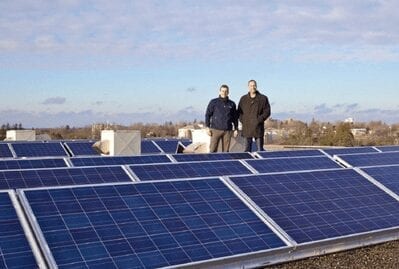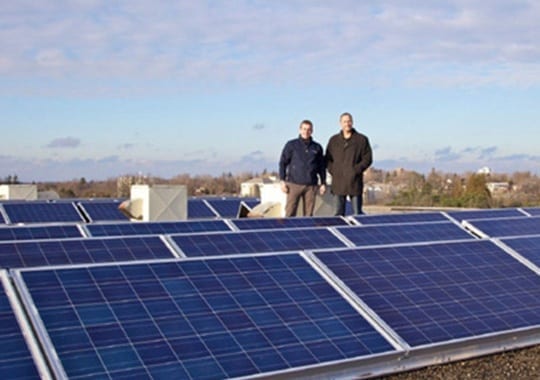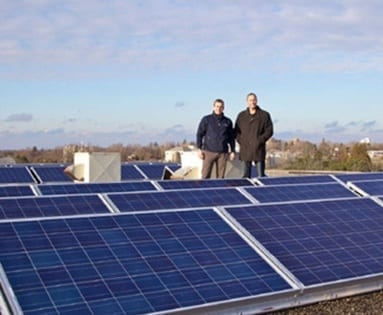


Toronto Star: Skyline is Retrofitting for the Future
At first glance, 40-year-old residential apartment buildings may not appear to be the picture of environmental sustainability, but increasingly owners of structures of that vintage — and even much older — are making efforts to bring them into greener status.

Skyline receives the M.A.C. award, from left, Martin Castellan, Jason Castellan, Jason Ashdown, David Suzuki, Maria Duckett and Matt Organ.
December 14, 2012 – YourHome.ca (Toronto Star) by Jennifer Brown
At first glance, 40-year-old residential apartment buildings may not appear to be the picture of environmental sustainability, but increasingly owners of structures of that vintage — and even much older — are making efforts to bring them into greener status.
One such company is Guelph-based Skyline Apartment REIT, which recently won the Environmental Excellence Award from the Federation of Rental-housing Providers of Ontario (FRPO) at its recent Marketing, Achievement and Construction (M.A.C.) Awards last month.
The FRPO Environmental Excellence award recognizes a rental housing provider who has demonstrated excellence in environmental practices. This could include energy conservation, water conservation, recycling or other environmentally conscious practices. Entries are judged based on the level of conservation or recycling achieved and the quality of environmental accomplishments when compared to an average rental housing provider in the province.
Skyline has been focused on trying to make its more than 100 properties greener since 2006, when it launched a portfolio efficiency plan to look at where they were losing energy by way of gas, water and hydro.
“Through that analysis, we came up with a plan that had both monetary return and also lessened the carbon footprint of the buildings we own and manage. We have also been applying that to buildings we buy from now on,” says Jason Ashdown, CSO at Skyline.

Jason Ashdown, right, CSO of Skyline, and Will Beardmore from Bluewater Energy stand among some of the solar panels Skyline has installed on the roof of one of its rental buildings in Guelph.
The plan included looking at everything from toilets to fridges to high-efficiency boilers, lighting and even tenant education in the form of resident outreach programs and community gardens.
“We also tested occupancy sensors that gently creep down a resident’s heat when it wasn’t occupied. We’re constantly looking for new technologies to help us save and reduce our carbon footprint to make older apartment buildings more efficient,” says Ashdown.
Occupancy sensors are used to decrease energy consumption in buildings with electrical heat by reducing the temperature in units that are vacant for an extended period of time. Once the occupant returns, the heat returns to normal levels. Skyline has used these sensors in two pilot projects. “We are awaiting results of the 2012/13 heating season to establish firm results. Hydro savings are estimated at 15 to 20 per cent,” he says.
The company also started generating its own hydro on rooftops with solar photovoltaic systems, working with the microFIT Program through the Ontario Power Authority.
“I guess all of these things combined made us innovative,” says Ashdown.
Skyline manages almost 9,000 apartment units in 42 communities across Ontario. Most of the buildings it owns are 40-plus years old or 10 or 15 years older.
“We have the ability to make changes to how we operate, how we renovate and to influence those around us. Skyline will continue to strive to make each of our properties more efficient and environmentally-friendly while serving as an example of good stewardship to staff, residents, stakeholders and the public,” says Ashdown.
To communicate with residents, Skyline sent leaflets to renters and illustrated how turning off their air conditioning when they go to work could save energy, and explained the impact of things such as a dripping tap.
“We knew if we could change people’s habits and save even 2 per cent on an energy bill, it had a substantial impact across the portfolio,” says Ashdown.
He believes tenants looking at two different buildings to move into will choose one where the landlord is being environmentally conscious.
By the end of December, Skyline will have 71 rooftop solar systems installed across its portfolio. The total annual production of each rooftop system is approximately 12,500 kWh per year. Considering the average Canadian family uses approximately 32 kWh per day, each rooftop system will generate enough energy to power 390 homes for a day. The total of these six systems are powering the equivalent of 75 homes a year.
“We find our managers and residents are more interested in this kind of thing than people might think. If you’re an environmentally conscious person living in a building that isn’t environmentally conscious it probably gets on your nerves. Our tenants have been very receptive,” says Ashdown. “If we can make changes every day and give them the facilities they need to make those changes, it all helps.”
Low-flow shower heads and aerators reduce water use at Skyline buildings by up to 60 percent. “Considering a typical five minute shower can use up to 95 litres of water, and these new shower heads will save 45 litres per shower, Skyline is saving up to 500,000 litres per day across our portfolio.”
Skyline has also replaced less efficient top-loading washers with high-efficiency machines in most buildings. These machines use only 48 litres of water compared to the 112 litres used in top-loading washers. If each rental suite typically washes 200 loads of laundry per year, by saving 64 litres of water per load, tenants reduce water use from laundry alone by over 100,000,000 litres per year.